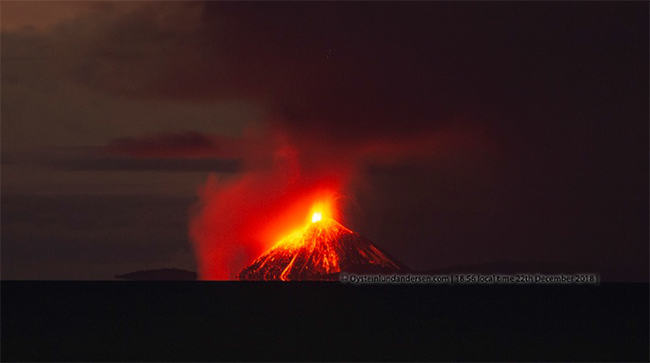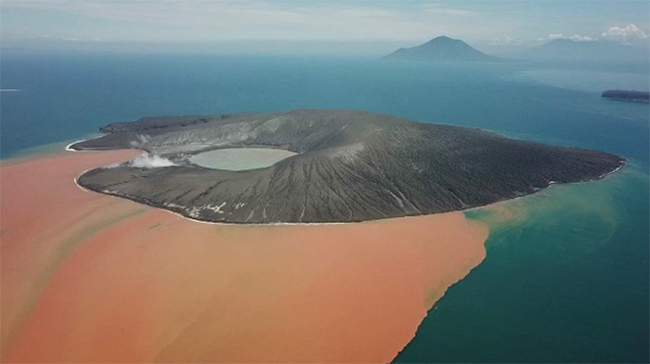Child of Krakatoa – why the 2018 eruption caused a tsunami
09/04/2019 By BGS Press
The volcano Anak Krakatau (‘Child of Krakatoa’), located between Java and Sumatra, collapsed in December 2018, causing a devastating tsunami that killed hundreds of people and displaced tens of thousands more living on the coasts of Indonesia. Recent scientific research has found that the tsunami was caused by an eruption-triggered landslide generated as the volcano collapsed into the Sunda Strait.
Anak Krakatau is a small volcano that formed in the caldera of Krakatau (Krakatoa) following its cataclysmic eruption in 1883, which was the deadliest in recorded history with over 36 000 deaths and led to global climactic effects. Anak Krakatau first emerged above the waves in 1930 and reached a pre-collapse height of 327 m above sea level. On 22 December 2018, an eruption led to the collapse of the south-western flank of the volcano, with the resulting landslide generating a tsunami that caused devastation along the nearby coasts of southern Sumatra and west Java.
The major factors that led to the collapse of Anak Krakatau were:
- its location on the north-eastern flank of a 220 m-deep submarine trough
- the migration of the volcano itself closer to the edge of the trough
- the very weak base of the volcano, which was formed of older volcanic deposits
In addition, the volcano had grown very quickly over the last 90 years to form a steep-sided cone of unstable volcanic material.
The results of modelling indicate that the landslide consisted of between 0.2 and 0.4 km3 of volcanic material. Initial numerical simulations of tsunami generation and propagation match to a high degree the recordings from tide gauges on the coasts of Sumatra and Java, as well as observations recorded from eye witnesses.
- Watch a video of a numerical tsunami model

Anak Krakatau 20 days after the eruption and collapse, on 11 January 2019. (Reynolds J, 2019. Post-collapse image of Anak Krakatau. Accessed Jan. 11, 2019, on https://twitter.com/hashtag/Krakatau?src=hash.)
This is the first major eruption-generated tsunami since the devastating Krakatau event of 1883 which killed over 36 000 people – it demonstrates yet again the lack of preparedness of countries threatened by tsunamis and highlights the urgent need for better mitigation and warning.
Prof David Tappin, BGS Marine Geologist and visiting professor at University College, London.
Numerical modelling of eruption generated tsunamis is far less developed than for other tsunami mechanisms – such as earthquakes and landslides. The Anak Krakatau event is timely in that it should stimulate the development of new models that will underpin improved mitigation strategies.
Prof Stephan Grilli, numerical modeller at the University of Rhode Island.
Prof Tappin will present the findings of this research at the General Assembly of the European Geosciences Union (EGU) in Vienna, Austria, on 10 April 2019.
This research was a collaboration between
- BGS, UK
- Institut Teknologi Bandung, Indonesia
- University College London, UK
- University of Birmingham, UK
- University of Rhode Island, USA
- University of Santa Cruz, USA
Funding for the research was provided by BGS, the Natural Environment Research Council (NERC) and US National Science Foundation (NSF).
Relative topics
For further details or to arrange media interviews please contact:
Sarah McDaid
Email: sarah@mcdaidpr.co.uk
Tel. 07866 789688
The press conference details can be found here:
https://www.egu.eu/gamedia/2019/press-conferences/#103
NB The press conference will be live streamed from the same webpage.
The following are available for interview:
Professor David Tappin, British Geological Survey
For additional information go to: www.bgs.ac.uk
British Geological Survey



